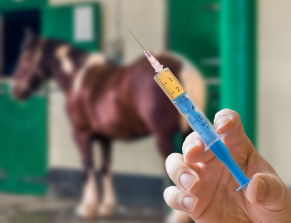AAEP Releases Equine Infectious Anemia Guidelines
AAEP
Comprehensive guidelines providing the most current information on diagnostics, transmission, risk factors, control and biosecurity strategies for Equine Infectious Anemia (EIA) have been published online by the American Association of Equine Practitioners (AAEP).
EIA is a viral disease with no cure and no vaccine for prevention. Horses confirmed positive can be quarantined for the remainder of their lives but are usually euthanized. According to USDA APHIS Veterinary Services, 1,187,536 EIA tests were conducted in the U.S. in 2018, resulting in detection of 51 positive horses.
The AAEP’s EIA Guidelines place special emphasis on recent changes in the epidemiology of the disease in the U.S. According to guidelines’ co-author Angela Pelzel-McCluskey, DVM, MS, national equine epidemiologist for USDA APHIS Veterinary Services, a new high-risk group has emerged in the past five years in which the primary method of disease spread is iatrogenic transmission—most commonly through needle, syringe and IV set reuse and possibly through blood contamination of multi-dose drug vials and use of illegal blood and serum products from other countries.
“While our cases of EIA in the U.S. used to be found primarily in untested or under-tested populations with disease spread by biting flies, the majority of EIA cases are now being found in Quarter Horse racehorses with ties to unsanctioned racing,” said Dr. Pelzel-McCluskey. “Investigation of these cases has shown that unhygienic practices by the owners and trainers of these horses is spreading the disease by iatrogenic means.”
Dr. Pelzel-McCluskey advises equine practitioners to be aware of the potential for EIA transmission in this population and to provide educational outreach to their clients on testing high-risk horses and implementing appropriate biosecurity practices to prevent disease spread.
The EIA Guidelines, available as a PDF file, were co-authored for the AAEP’s Infectious Disease Committee by Drs. Pelzel-McCluskey and Katie Flynn, equine staff veterinarian at the California Department of Food and Agriculture.
View the EIA Guidelines or save them to your phone or tablet for future reference at www.aaep.org/EIAguidelines. In addition to EIA, AAEP guidelines for 18 other equine infectious diseases are available online.
The American Association of Equine Practitioners, headquartered in Lexington, Ky., was founded in 1954 as a non-profit organization dedicated to the health and welfare of the horse. Currently, AAEP reaches more than 5 million horse owners through its over 9,000 members worldwide and is actively involved in ethics issues, practice management, research and continuing education in the equine veterinary profession and horse industry.











